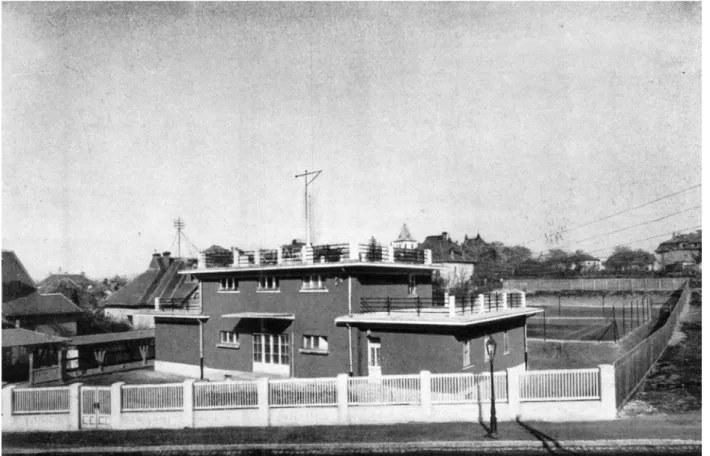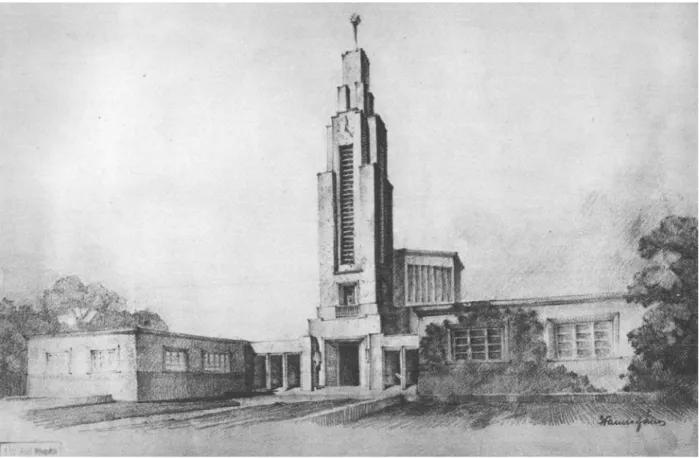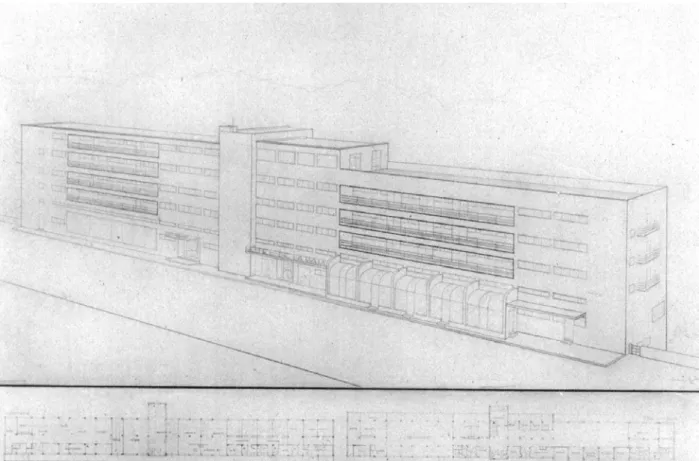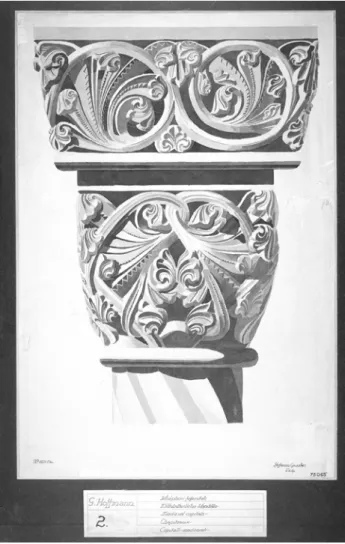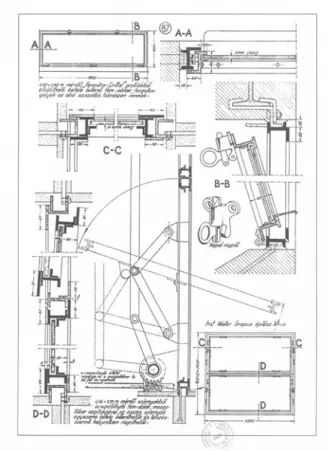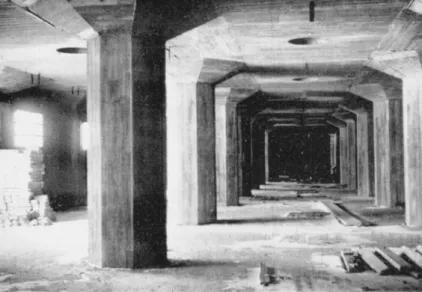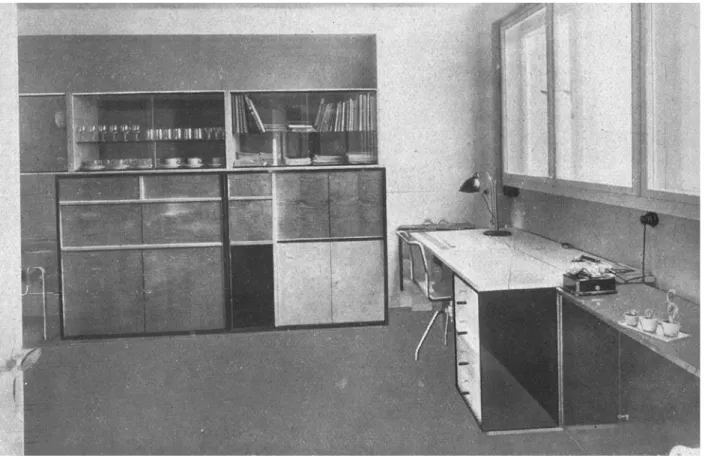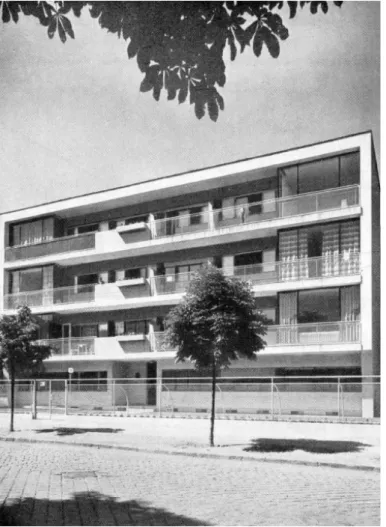THE INFLUENCE OF THE MODERN MOVEMENT ON HUNGARIAN ARCHITECTURAL EDUCATION DURING THE INTERWAR PERIOD
Rita Karácsony and Zorán Vukoszávlyev
Budapest University of Technology and Economics, Department of History of Architecture and Monument Preservation, Műegyetem rkp. 3 1111 Budapest, Hungary
E-mail: karacsonyr@gmail.com, E-mail: zoran@eptort.bme.hu DOI: 10.24427/aea-2019-vol11-no3-03
Abstract
The influence of the Modern Movement was increasingly felt in Hungary from the end of the 1920s. As time passed, archi- tectural education also needed to respond to these changes. How did the professors, who designed in historical styles, react to the new situation, and how did the students respond? Who were the people who first stimulated interest in modern architecture, and who did they inspire? What kind of institutional or structural modifications did all these initiatives bring about at the Architectural Faculty of Budapest Technical University?
There are three noteworthy episodes in the history of introducing modern approaches at the Faculty. The first event of great significance was the establishment of the Department of General Building Design in 1922 besides the three long-standing historical departments: the Departments of Ancient, Middle and Modern Ages. This began a disengagement with the era of historicism. However, students in the older years continued to receive their design assignments from the historical de- partments, and were expected to design in historical styles taught by the professors. Thus architectural education could be considered conservative even by the end of the 1920s.
On the other hand, some students were able to bring progressive modernism directly to the University. At the student exhibition held in 1927, a few “brave” drawings independent of any department appeared among the designs in histori- cal styles. These included a design by György Rácz inspired by Le Corbusier that was showcased thanks to the curator, a student named György Masirevich. Farkas Molnár – who returned from the Bauhaus school – submitted a design influ- enced by modern German architecture. Within a few years Masirevich, Rácz and Molnár joined CIAM, and then its sub- group: CIRPAC.
It was not only students, but also some professors who played an indisputable role in ushering in modern architecture, even if their work and teaching methods could generally be regarded as examples of “conservative progression”. The third and most important date of the investigated period was 1930, when architectural education began to be given high priority.
That year another student exhibition was organised by a professor, Iván Kotsis, which was linked to the 12th Internatio- nal Congress of Architects held in Budapest. Plans designed by students in the modern spirit constituted the majority at that exhibition. It was in the same year that professor Hültl as the Rector of the University voiced his opinion on modern architecture: according to him, modernism should not be used for certain types of buildings; however, he did not want to oppose all new directions in architecture. This duality of approach can well be detected in his private practice.
Therefore it was the so-called “other modern” rather than progressive modernism that became institutionalized at the Faculty due to the influence of some professors whose aim was to comply better with local circumstances and materials.
To achieve this it was indispensable to get the knowledge of the past, so teaching history of architecture remained a signi- ficant part of the curriculum. It was Professor Kotsis and his colleagues who laid out this path and their heritage was still prevalent after WWII.
Keywords: architectural education; “other modern”; Interwar period
”CONSERVATIVE PROGRESSION”. THE INFLUENCE OF THE MODERN MOVEMENT ON HUNGARIAN ARCHITECTURAL ...
INTRODUCTION
This paper investigates the changing charac- ter of Hungarian architectural education around 1930.
During that time, due to the influence of the Modern Movement, several alterations took place in the curricu- lum adopted by the Architecture Faculty at Budapest Technical University (BTU)1, which was the only institu- tion in Hungary where one could become a certified architect during the Interwar period.
Although those changes could be considered small steps at first sight, they were unquestionably important in having contributed to the emergence of modern architectural trends at the university. They concurrently enabled gradual disengagement from de- signing in historical styles and helped place the sub- ject of Architectural design in the centre of the curricu- lum, partly by increasing the number of corresponding classes and additionally by introducing the subject into the third semester.
Some students, a number of representatives of the architectural profession outside the university, and even some professors at BTU played a significant
role in reforming architectural education. Who were the ones urging radical changes? Who were against the new directions and how could the concept of the so-called “conservative progression” finally evolve at the Architecture Faculty of BTU? The aim of this pa- per is to answer these questions by investigating the professional architectural press of the era. Further- more, its purpose is to highlight the characteristics of the teaching method “conservative progression”. This teaching method must have been effective in the 1930s and 1940s, and may be worth considering even in our times.
The ROle Of aRChITeCTURe sTUDeNTs
Some students got acquainted with the prin- ciples of the Modern Movement and the Bauhaus on their own; however, it was in 1927 at the university that they found opportunities to draw attention to the mod- ern architecture through their own work. From 1920 onwards student exhibitions were organised at BTU almost every year [K. Héberger 1979, 627.], but the ex-
Fig. 1. Publication of the student exhibition of 1927. © Credit: ”Néhány terv az építészkiállításról” (1927), Tér és Forma, a Vállalkozók Lapja melléklete, Vol. 48, No 5, 6–7.
1 Royal Joseph Technical University (1871–1934); Joseph University of Technology and Economics (1934–1949)
hibition of 1927, put on by one of the students, György Masirevich (1905–1989), turned out to be a special one:
several students displayed designs and artworks that had been created independently of any university as- signments. Such, for instance, was the entry called Vil- la le Corbusier submitted by the second grade student György Rácz (1907–1988), inspired by the writings of the famous architect: Towards a New Architecture [M.
Rácz 2006, 3.]. Another student, Farkas Molnár (1897–
1945), showcased a design of a dwelling house made around 1924–25 in Germany during his former studies2 (Fig.1). Molnár decided to join the Bauhaus School in 1921 after his disrupted studies at BTU, but in 1925 he returned to Hungary and went back to university to obtain his degree and be able to work as an architect [A. Ferkai 2011, 66, 172.].
Molnár and his two younger fellow students, Rácz and Masirevich, soon became members of the CIAM’s subgroup (CIRPAC), which promoted progres- sive modern architecture [A. Ferkai 1998, 255–56.].
However, in 1927, their progressive designs, exhibited
against other student drawings executed in historical styles such as Neo Baroque, were considered by most of the visitors as “foreign” and the authors called “out- siders” [K.L. 1927, 188.]. Why were these drawings too brave?
Around 1927 the historicist approach was still prevalent at BTU. Architectural design started with theoretical classes only in the 4th semester and then continued with an additional 6 hours of practice work- shops through the 5th and 6th semesters3. In the final year students only had 15 hours per week of design and then were required to do their diploma project at one of the three long-standing [G. Salamon 2016, 192–213] historical departments (Departments of An- cient, Middle and Modern Ages) in a historical style.
Studying history of art and architecture as well as practising architectural forms made up a significant portion of the curriculum all the way from the very first semester, because – according to the historicist ap- proach – these subjects were indispensable to Archi- tectural design.
Fig. 2a.The latest building of Professor Hültl in 1929. © Credit: Komor, M. (1929), Az építész tanárok hivatásáról, Tér és Forma, Vol. 2, No 3, 92.
2 Published in 1927. [“Néhány terv az építészkiállításról” 1927, 6.]
3 Schedules of the Architecture Faculty in 1926/27. BUTE Archives http://public.omikk.bme.hu/bme_evkonyv/weblap.php?step=2&cat=o rarendek&konyvtar=./orarendek/1926_27_2/&alcim_id=863
4 For example Professor Hültl ran his office at the Modern Ages Department between 1913 and 1940.
„CONSERVATIVE PROGRESSION”. THE INFLUENCE OF THE MODERN MOVEMENT ON HUNGARIAN ARCHITECTURAL ...
The ROle Of aRChITeCTs OUTsIDe The UNIveRsITy
It was not only the students mentioned above (the “outsiders”) who were active in making way for rad- ical changes through their own work during the second half of the 1920s; some other members of the archi- tectural profession also made significant contributions towards accomplishing up-to-date standards of edu- cation in Hungary. These included Pál Müller [P. Müller 1926, 295–98.] and Marcell Komor [M. Komor 1929, 92–98.], who both considered the practice of teaching historic architectural styles exaggerated at BTU. Mar- cell Komor (1868–1944) referred to historical studies as obstacles hindering the spread of modern architecture both in the field of education as well as in the profes- sors’ private practice. He pointed out that professors should open up to the new trends of architecture in their own work, and mentioned the recent buildings by Professor Iván Kotsis (1889–1980) and Professor Dezső Hültl (1870–1945) appreciatively as positive examples (Fig.2a; Fig.2b). Private practice was strongly related to teaching architecture during the interwar period be- cause heads of departments were allowed to run their own offices at the university [P. Granasztói 1965, 202.],
so students had the opportunity to be informed of the actual designs and even to work there as draftsmen4.
In 1930 the international architecture profes- sion could also form an opinion about architectural education in Hungary. The current state of education was one of the main topics of the 12th International Congress of Architects held in Budapest [“A XII. Nem- zetközi Építészkongresszus tárgyalási anyaga”, 1930, 29.], so the Architecture Faculty of BTU decided to organise a special student exhibition under the direc- tion of professor Iván Kotsis. The expo took place in the assembly hall of the university. It was only three years after the exhibition of 1927, but this time the majority of student designs were more or less related to the modern approach [“A Budapesti M. Kir. József Műegyetem építész hallgatóinak kiállítása 1930” 1930, appendix] (Fig.3a; Fig.3b; Fig.3c). Despite that, Kotsis himself was not fully satisfied with the compilation: for example, he was missing the floor plans of the exhib- ited designs and claimed that in most of the cases the modern approach was only adopted in the sense of abandoning the forms of historic architecture. That is why he could accept a critique by a foreign journalist, who referred to the drawings as ones “grown under glass” [I. Kotsis 2010, 199–200.].
Indeed, those student designs were a far cry from progressive modernism: some of them contin- ued to use historical forms, while some others rather resembled the German style of premodern industrial architecture from the 1910s. Despite all these, the changes that took place in Hungarian architecture education between 1927 and 1930 were definitely Fig. 2b.The latest building of Professor Kotsis in 1929. © Credit:
Komor, M. (1929), Az építész tanárok hivatásáról, Tér és Forma, Vol. 2, No 3, 96.
Fig. 3a. Student design displayed at the Budapest Technical University in 1930. © Credit: “A Budapesti M. Kir. József Műegy- etem építész hallgatóinak kiállítása 1930”(1930), Technika, Vol. 11,
No 7, appendix
Fig. 3b..Student design displayed at the Budapest Technical University in 1930. © “A Budapesti M. Kir. József Műegyetem építész hall- gatóinak kiállítása 1930”(1930), Technika, Vol. 11, No 7, appendix
Fig. 3c..Student design displayed at the Budapest Technical University in 1930. © Credit: “A Budapesti M. Kir. József Műegyetem építész hallgatóinak kiállítása 1930”(1930), Technika, Vol. 11, No 7, appendix
”CONSERVATIVE PROGRESSION”. THE INFLUENCE OF THE MODERN MOVEMENT ON HUNGARIAN ARCHITECTURAL ...
perceivable in the exhibited works and the fact that some professors also participated in the exhibition gave further momentum to this process of renewal. We could say that an inner need for reform was already in the air.
The ROle Of pROfessORs aT BTU
Some professors, first of all Professor Kotsis, admitted modern approaches to the university, albeit with compromises. So what were the most significant milestones of this reform process?
As the first step, the General Design Department was established in 1922, directed by Iván Kotsis. In re- ality, the status of the department became financially and institutionally consolidated only between 1926 and 1928. This delay shows the reservations that the Min- istry of Religion and Education had regarding modern approaches represented by Kotsis’s circle [K. Héberg- er 1979, 599–601.]. In the 1920s historical styles, espe- cially Neo Baroque, were principally supported by the state and the church because the conservative political
leadership was against every form of progression in the field of architecture as well as architectural education [A. Ferkai 1998, 245–46.].
From 1922 onwards, the General Design De- partment joined the three historic departments in teaching architectural design in lower-level classes.
With this change a gradual process of disengagement from historical styles began to take place, but in real- ity even Kotsis’ Department abandoned historic forms only from 1928 onwards [I. Kotsis 2010, 173.]. Similarly, from that same year, students could choose Kotsis as the supervisor in their more advanced classes and for their diploma project5.
Modern approaches appeared parallelly at the three historic departments and at the Department of Drawing (in which students could design from 1929 onwards [Z. Szentkirályi 2006, 203.]), but the influence of the Modern Movement was undoubtedly the stron- gest in Kotsis’ Department. This fact is well reflected in the material of the student exhibition of 1930 (Fig. 4).
It is remarkable that not a single design submitted for that expo originated from the Middle Ages Department
Fig. 4. Student design displayed at the Budapest Technical University in 1930. © Credit: “A Budapesti M. Kir. József Műegyetem építész hallgatóinak kiállítása 1930”(1930), Technika, Vol. 11, No 7, appendix
5 Schedules of the Architecture Faculty in 1928/29. BUTE Archives http://public.omikk.bme.hu/bme_evkonyv/weblap.php?step=2&cat=o rarendek&konyvtar=./orarendek/1928_29_1/&alcim_id=881
headed by István Möller (1860–1934). This is probably because Möller taught Architectural design according to the style of the Middle Ages even in 1928/296. How- ever, in another section of the exhibition in which stu- dent paintings, drawings of building constructions and depictions of historical architecture were showcased, several student drawings presented medieval building elements (Fig. 5).
The fact that drawings of historical architecture and architectural forms were also part of the exhibition in 1930 clearly shows that the professors at the Fac- ulty, while gradually opening up to the new tendencies, continued to hold the teaching of architectural history in high esteem. The educational reform worked out in
detail during the preparations for the 12th International Congress of Architects went as far as cutting back the number of historical classes and condensing those sub- jects into the first six semesters [Z. Szentkirályi 2006, 205–206.], but there was no willingness to eliminate them from the schedule. The most significant part of the reform was placing Architectural design in the centre of the curriculum from the 1931/32 academic year, intro- ducing it into the third semester and increasing the num- ber of lectures and practical classes7. Urban design and classes on industrial and agricultural architecture were also included in the curriculum thanks to the reform.
Nonetheless, this progression could still be considered conservative. Professor Kotsis himself de- scribed the educational method of his choice as follows:
”...I believe the right way is conservative progression.
By ‘progression’ I mean satisfying the requirements of current times by the use of progressive structures in a purposeful and economical manner, while the term
‘conservative’ refers to the seriousness, architectural self-discipline and self-critique that we may inherit by studying the legacy of past eras. And since in my humble view, it is this approach that lays out the right direction for architectural design, the same should be adopted as a method for teaching design itself.” [I. Kot- sis 1930, 195.]
Borrowing the terms applied by Iván Kotsis, the next part of the paper investigates further progressive and then conservative aspects of Hungarian architec- tural education around 1930.
pROgRessIve aspeCTs Of aRChITeCTURal eDUCaTION aT BTU
International architecture was taught by the pro- fessors with reliance on foreign professional publica- tions and other materials. For instance Kotsis asked for large-scale reproductions of the photos of modern German architecture showcased at the exhibition of the 12th International Congress of Architects at the Kunst- halle in 1930 [“Architectura” 1930, 94–113.] and later used them as educational materials [I. Kotsis 2010, 199.] (Fig. 06). On behalf of BTU, senior lecturer Tibor Kiss (1899–1972) ordered copies of the whole plans (in- clusive of construction plans and reinforced concrete plans) of Villa Savoye from Le Corbusier during his study trip in Paris [T. Kiss 2007, 134.].
Fig. 5. Student drawing of a Medieval capital. © Credit: Plan Col- lection and Archives, Department of History of Architecture and
Monument Preservation, BUTE, No 103 244
6 Curriculum of the Architecture Faculty in 1928/29. BUTE Archives http://public.omikk.bme.hu/bme_evkonyv/weblap.php?step=2&cat=t anrendek&konyvtar=./tanrendek/1928_29/&alcim_id=1337
71931/32: III-IV. semester: 2 (lecture) – 6 (practice); V-VI. semester: 3 (lecture) – 10 (practice); VII-VIII. semester: 20 (practice), Schedules of the Architecture Faculty in 1931/32. BUTE Archives
8Minutes of the meetings of the University Board, 19. 06. 1931. BUTE Archives
Fig. 6. Photos of modern German architecture displayed at the 12th International Congress of Architects in 1930. © Credit:
“Architectura”, XII. nemzetközi építészkongresszus és építészi tervkiállítás (1930), Budapest, 98–99.
Fig. 7. Materials for the subject of Building Constructions taught by Professor Sándy. © Credit: Sándy, Gy. (1999), Épületszerkezet-
tani táblák 1932, Gyorsjelentés Kiadó, (reprint), 87.
In 1930 and 1931 Professor Kotsis made sug- gestions to the National Board of Scholarship Programs about creating a regular scholarship program for stu- dents and teachers of architecture in order to assist them in getting acquainted with modern architecture by travelling abroad8. The Board was established in 1927 by the state [I. Romsics 1999, 184–187.] and offered opportunities for researchers, artists and architects to study at one of the Collegium Hungaricums or to make study tours abroad. Financial support provided for edu- cational and cultural purposes was an important instru- ment of Hungarian politics during the interwar period, and some professors as board members could even make recommendations on who should receive grants and scholarships9.
Furthermore, the curriculum of the Architecture Faculty also laid special emphasis on teaching engi- neering aspects of architecture. Apart from traditional constructions, contemporary structures were also taught at BTU. One example is Professor Gyula Sándy (1868–1953), who taught Building constructions and presented within the frame of this subject, among others, a type of metal window designed by Walter Gropius [Sándy, Gy. 1999, 87] (Fig. 7). Other profes- sors, like Győző Mihailich (1877–1966) – a pioneer of reinforced concrete structures in Hungary and a lec-
9For example Professor Hültl was a board member in the 1930s.
”CONSERVATIVE PROGRESSION”. THE INFLUENCE OF THE MODERN MOVEMENT ON HUNGARIAN ARCHITECTURAL ...
Fig. 8a.Grain elevator of Csepel (1926–28, designed by Professor Mihailich and Professor Hültl) © Credit: “A M. Kir. budapesti vám-
mentes kikötő gabonatárháza” (1935), Vízügyi Közlemények, Vol. 17, No 4, 565.
Fig. 8b. Bus garage in Cházár András street, Budapest (1928–
30, designed by Professor Mihailich and Professor Hültl) © Credit:
Szerényi, Ö.(1930), Budapest székesfőváros autóbusz-garázsa, Magyar Építőművészet, Vol. 30, No 10–11. 9.
turer on Iron and reinforced concrete constructions at the university [G. Tassi 1984, 63–64.] – set an ex- ample by incorporating innovative solutions into their own work. Relevant structures from the investigated period include the grain elevator of Csepel (1926–28, Győző Mihailich together with Dezső Hültl) and the bus garage in Cházár András street, Budapest (1928–30, Győző Mihailich together with Dezső Hültl) (Fig. 8a;
Fig. 8b).
10 Legacy of Dezső Hültl, Hungarian Architectural Museum, No. 71.06.9.101.10
CONseRvaTIve aspeCTs Of aRChITeCTURal eDUCaTION aT BTU
BTU professors stood up for the importance of teaching architecture and architectural forms of the past because they considered it essential for funda- mental knowledge. It was believed that by such studies architects and students could find insights into eternal truths, improve their sense of proportion and last but not least, as Dezső Hültl highlighted in his welcome speech held in German at the opening of the student exhibition in 1930, these historical studies could help to preserve historic monuments in a professional way10.
In addition to this, some professors rejected any direct copying of forms and solutions of modern archi- tecture. Instead they called the students’ attention to the need of better compliance with local circumstanc- es, structures and materials [I. Kotsis 2010, 173–74.].
This direction was strengthened by the influence of Scandinavian and Italian architecture that became ba- sic reference during Architectural design classes in the interwar period.
Dezső Hültl gave his inauguration speech as the Rector of the Technical University in 1930, a few days after the sessions of the 12th International Congress of Architects had finished. In his speech Hültl referred to the congress and especially to one of the interna- tional speakers, namely German Bestelmeyer from Munich, who claimed that modern architecture was not yet appropriate for every building type. Hültl was of the same opinion, asserting that in case of religious buildings, museums or town halls the unornamented style of modern architecture was not yet able to meet the existing representational demands. However, Hültl did not reject all aspects of new architectural direc- tions and was convinced that modern architecture would be able to find its own forms in the future, and for this reason it would be suitable for every building type, because there was a general need for decora- tions [D. Hültl 1930, 155–56.]. All in all, Hültl’s speech can also be considered a manifestation of conservative progression. It is important to notice that Hültl was the only one among the elder professors who always sup- ported educational reforms suggested by his younger colleague Kotsis.
CONClUsION
Architectural education at BTU was indirectly in- fluenced by the Modern Movement and the Bauhaus, but things could have been very different.
Fig. 9. Student designs at the School of Applied Arts. © Credit: Györgyi, D. (1931), Az O. M. K. Iparművészeti Iskola építészeti szakok- tatása, Tér és Forma, Vol. 4, No 1, 36–37.
Almost exactly one hundred years ago, the au- thors of the educational reforms of 1919 wanted to establish two new General Design Departments and four further ones for Urban Design, Industrial and Ag- ricultural Building Design, Interior Design and Art His- tory. These departments would have been headed by architects – Móric Pogány (1878–1942), Lajos Kozma (1884–1948), Béla Málnai (1878–1941) etc. – who could have represented progressive directions of architecture at the university. The reform plan had one more signifi- cant part, which was to establish an additional, fifth art
class for graduate students. Although the reform plan was confirmed in spring, at the same time as the Com- munist takeover of Hungary, the whole set of reform initiatives were abolished after the Republic of Coun- cils [I. Romsics 1999, 123–131.] collapsed on the 1st August [K. Héberger 1979, 458–62.]. If those reforms had been introduced at BTU, they could have triggered more radical changes in the curriculum; it is however impossible to prove whether they would have brought more positive results.
Fig. 10a. Workroom designed by Farkas Molnár. © Credit: “Architectura”, XII. nemzetközi építészkongresszus és építészi tervkiállítás (1930), Budapest, 87.
”CONSERVATIVE PROGRESSION”. THE INFLUENCE OF THE MODERN MOVEMENT ON HUNGARIAN ARCHITECTURAL ...
Fig. 10b. Residential house designed by János Wanner. © Credit:
Vándor, M. (1937), Kis családi házakról. Tér és Forma, Vol. 10, No 11, 330.
The influence of the Modern Movement and the Bauhaus was more discernible in the educational meth- ods of the School of Applied Arts in Hungary around 1930. Here students of Furniture Design and Architec- tural Department received smaller design assignments early on in their education, before finally being required to design a house in its complexity, starting off with the initially designed interior architecture, and also giving consideration to the environment of the building (Fig.
9). Dénes Györgyi (1886–1961), the head of the Depart- ment, wanted to create strong connections between all the departments of the school and to place architec- tural thought in the centre as the basis for education in applied arts [D. Györgyi 1931, 33–44.]
When comparing the student exhibition of 1930 at the Technical University and the jubilee exhibition of the School of Applied Arts held in the same year, it can be seen that the presence of modern approaches was in fact stronger at the latter institution. However, chang- es and reforms made at BTU thanks to the Modern Movement during the second half of the 1920s, even if
small in scale and gradual in terms of progress, were vitally important in the history of teaching architecture as well as in introducing modern approaches at the university of long historic heritage. The role of some professors was indubitable in this process of change, which indicates the existence of an inner need for pro- gression. It was, however, progression with compro- mises: the concept of conservative progression which evolved during these years helped the teachers to de- liver solid knowledge and did not hinder newly gradu- ated architects in their attempts to find their own way or even become modernists, as did, among others, János Wanner (1906–1987) or Károly Dávid (1903–1973), who both worked at Le Corbusier’s office after their stud- ies [V. Hajdú, P. Ritoók 2010, 35.; A. Ferkai 2003, 81.]
(Fig. 10a; Fig. 10b). Conservative progression became the basis for architectural education of the 1930s and remained prevalent even after WWII.
lITeRaTURe
1. A XII. Nemzetközi Építészkongresszus tárgyalási anyaga (1930), “Építő Ipar – Építő Művészet“
vol. 54, No 7–8.
2. A Budapesti M. Kir. József Műegyetem építész hallgatóinak kiállítása 1930 (1930), “Technika” vol.
11, No 7, 1–5. + appendix. Abstract in English. [“The exhibition of the students at the Technical University of Budapest”]
3. Architectura, XII. nemzetközi építészkongresszus és építészi tervkiállítás (1930), Budapest.
4. Fehér K. – Krähling J. (2019), Építészettörténet és építészeti tervezés – Az építészoktatás megújulásának kérdései az 1930-as Nemzetközi Építészkongresszus műegyetemi kiállítása kapcsán, “Építés–Építészettudomány“ vol. 47, No 1–2, Abstract in English. [“History of architecture and architectural design – questions regarding the reforms of architectural education apropos of the Technical University exposition of the International Congress of Architects in 1930”]
5. Ferkai A. (2003), Le Corbusier és Magyarország, in:
Űr vagy megélt tér, Terc, Budapest.
6. Ferkai A. (1998), Hungarian Architecture between the Wars, in: Dora W. – József S.: The Architecture of Historic Hungary, Cambridge, The MIT Press.
7. Ferkai A. (2011), Molnár Farkas, Budapest, Terc.
8. Granasztói P. (1965), Vallomás és búcsú, Magvető, Budapest.
9. Györgyi D. (1931), Az O. M. K. Iparművészeti Iskola építészeti szakoktatása, “Tér és Forma”, vol. 4, No 10. Hajdú V., Ritoók P. 1. (2010), Modern Movement in Hungary, in: Plank I.: Fény és Forma, modern építészet és fotó 1927–50, Light and Form, modern architecture and photography 1927–50, Vince, Bu- dapest.
11. Héberger K. (1979), A Műegyetem története 1782–
1967, III., BME.
12. Hültl D. (1930), Dr. Hültl Dezső építőművész, Rec- tor Magnificus székfoglaló beszédéből: „A modern építésznevelésről”, “Építő Ipar”, vol. 54, no 39–40.
13. K.L. (1927), Építész kiállítás a Műegyetemen, “Tech- nika” vol. 8, no 6.
14. Kiss T. (2007), Befejezetlen önéletrajz, HAP Galéria, Budapest.
15. Komor M. (1929), Az építésztanárok hivatásáról,
“Tér és Forma” vol. 2, no 3.
16. Kotsis I. (1930), Építésznevelés a Műegyetemen,
“Tér és Forma”, vol. 3, no 3.
17. Kotsis I. (2010), Életrajzom, Budapest, HAP Galéria – Magyar Építészeti Múzeum.
18. Müller P. (1926), Az építészeti oktatás határairól,
”Magyar Mérnök és Építész Egylet Közlönye” vol.
60, no 50–52.
19. Néhány terv az építészkiállításról (1927), ”Tér és Forma” vol. 48, no 5.
20. Rácz M. (2006), Rácz György építész (1907–1988) emlékkiállítása, Budapest, HAP Galéria.
21. Romsics I. (1999), Hungary in the 20th century, Corvina, Budapest.
22. Salamon G. (2016), ‘Akademische’ Vorbilder für die polytechnische Architektenausbildung an der Joseph-Technischen Hochschule Budapest in der Gründerzeit in: Ebert C., Froschauer E. M., Salge Ch.: Vom Baumeister zum Master. Formen der Ar- chitekturlehre vom 19. bis ins 21. Jahrhundert, Uni- versitätsverlag der TU Berlin.
23. Sándy Gy. (1999), Épületszerkezettani táblák 1932, Gyorsjelentés Kiadó, (reprint).
24. Szentkirályi Z. (2006), Adatok a magyar építész- képzés történetéhez, in: Válogatott építészettörténeti és elméleti tanulmányok, Terc, Budapest.
25. Tassi G. (1984), Győző Mihailich (1877–1966),
“Periodica Polytechnica Civil Engineering” vol. 28, no 1-4.
”CONSERVATIVE PROGRESSION”. THE INFLUENCE OF THE MODERN MOVEMENT ON HUNGARIAN ARCHITECTURAL ...

